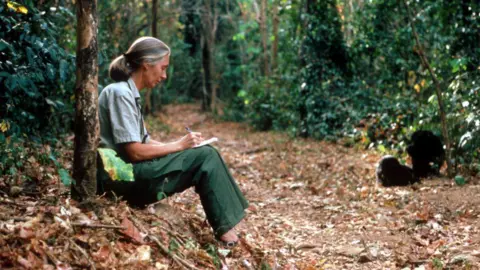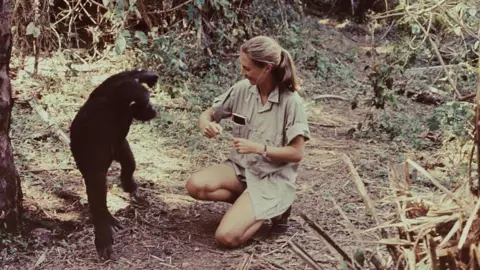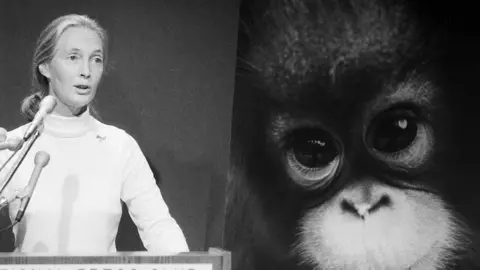Conservationist Dame Jane Goodall, a world-leading expert on chimpanzees, has died aged 91.
Her observations helped to reveal how closely related humans are to chimpanzees. She also worked tirelessly for conservation projects around the world
Dr Goodall died of natural causes while in California on a speaking tour of the US, according to a statement from the Jane Goodall Institute.
It said her discoveries “revolutionised science” and that she was “a tireless advocate for the protection and restoration of our natural world”.
The United Nations said it mourned the loss of Dr Goodall, saying that she “worked tirelessly for our planet and all its inhabitants, leaving an extraordinary legacy for humanity and nature”.
Greenpeace said it was “heartbroken” by her death, calling her “one of the true conservation giants of our time”.
Its co-executive director in the UK, Will McCallum, said: “Dr Goodall’s legacy is not only in science but in the global movement she helped spark to protect nature and give hope for a better world.”
Naturalist Chris Packham told the BBC that he counted her among his heroes, calling her “revolutionary” and “remarkable”.
“To have lost a hero at a time when we need all of them on the frontline fighting for life on earth is a tragedy.”
 Getty Images
Getty ImagesBorn in 1934 and raised in London, Dr Goodall said she became fascinated by animals after reading books like The Story of Dr Doolittle and Tarzan.
She met leading primatologist Prof Louis Leakey while staying on a friend’s farm in Kenya in her mid-twenties. Although she had no qualifications, Mr Leakey saw her potential and helped arrange her first research trip to the jungles of Tanzania in 1960.
That year, she became the first person to record witnessing an animal using a tool – a large male chimpanzee, who she had named David Greybeard, digging termites out of a mound with a stick.
Until then, it was thought only humans were intelligent enough to do so. Her observations challenged years of conventional scientific thinking and shaped the future of evolutionary science.
Her work was published in leading journals, and in 1965 she made the front cover of National Geographic, introducing the world to the emotional and social lives of the primates.
 Getty Images
Getty ImagesShe revealed that the animals form strong family bonds and even engage in warfare over territory. She featured in a television documentary narrated by Orson Welles, which saw her playing and wrestling with baby chimps.
Her approach – associating so closely with the animals she studied, naming them and even referring to them as “my friends” – was scoffed at by some, mostly male, scientists at the time. She undertook a PhD based on her findings, despite not having an undergraduate degree or any prior scientific training.
After her experiences in the field she became an activist, working to free chimpanzees kept in zoos or in captivity for medical research, and later urged action on climate change in the face of widespread habitat devastation.
She told the BBC in 2024: “We’re in the midst of the sixth great extinction… the more we can do to restore nature and protect existing forests, the better.”
Asked what kept her motivated late in life, she said: “Surely people want a future for their children.”
 Getty Images
Getty ImagesHer Jane Goodall Institute, founded in 1977, works to protect chimpanzees and supports projects aimed at benefiting animals and the environment.
Dr Goodall was appointed a Dame in 2003 and received the US Presidential Medal of Freedom in 2025.
She was known for travelling constantly for her work, telling the Times newspaper in 2022 that she had not slept in the same bed for more than three weeks since 1986.
Dr Goodall worked right up until her death, being interviewed on stage in New York a week ago. She was due to speak again at a sold-out event on 3 October in California.



